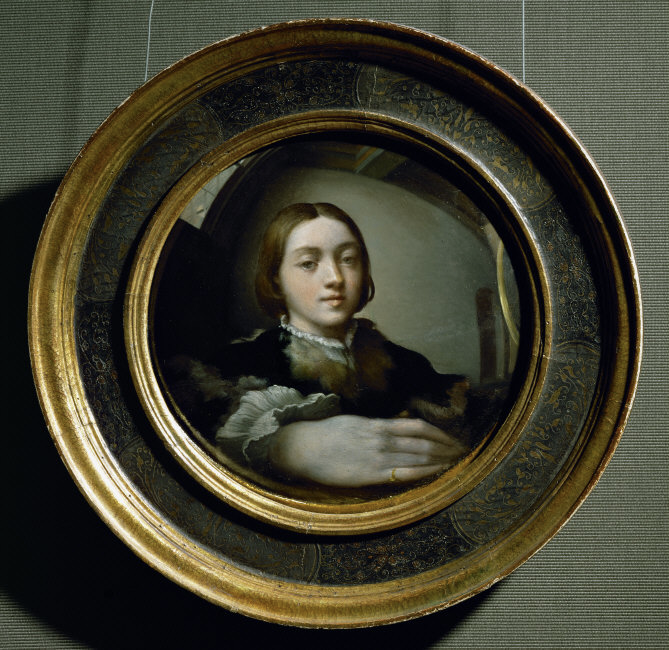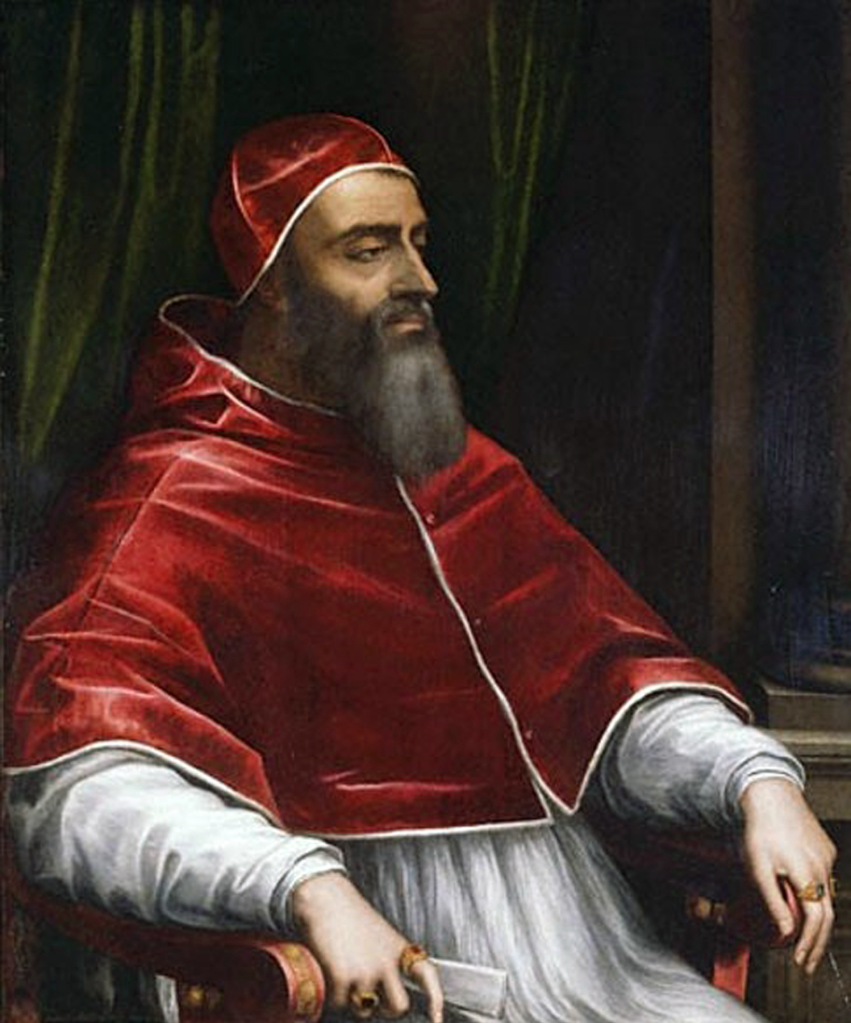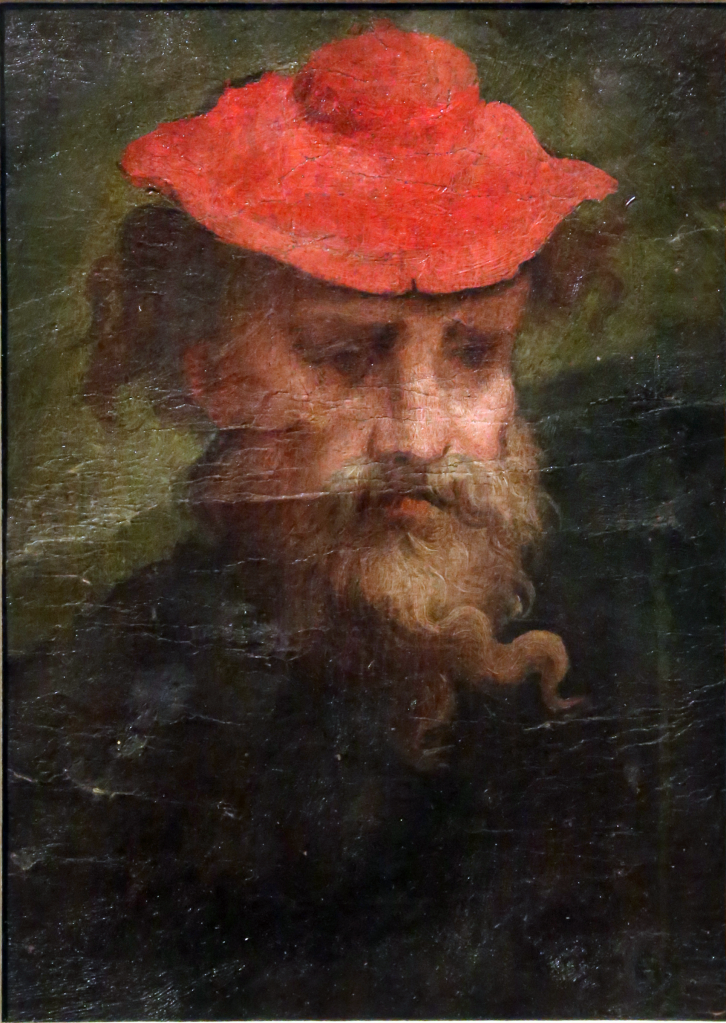Beginning with the Renaissance and running through our contemporary era it has been a recurring metaphor that painting has provided a window onto, or a mirror of, the world. So much so, that we may often forget the power of reflection and the conventions of reflecting the things surrounding us. Two examples include the foreground still life in the Northern Renaissance painting of “The Money Changer and his Wife” from 1514 by Quinten Massys and an M. C. Escher lithograph of the “Hand with a Reflecting Sphere” from 1935. Sandwiched in between is that great “Self-Portrait in a Convex Mirror” by Girolamo Francesco Maria Mazzola, otherwise known as Parmigianano.

“The Money Changer and his Wife”
1514
Oil on canvas
70.5cm x 67cm
Musée Louvre, Paris
There are two important literary examples associated with this single painting by Parmigianino: the first one historic, written by Vasari regarding the creation of this painting, and the second one modern, John Ashberry’s extensive and thoughtful meditation on this subject.
The artist is seen in a circular form: a sphere that has been cut in half, one part to be polished and glazed into a mirror and the second part to be prepared and used as the support for this very painting.
Although it is small in diameter, it is forceful in its imagery, and a perfect presentation piece intended to be seen by future patrons in Rome. We are confronted by his intense stare, slightly above center of the composition, and then the sweep of his shoulder and arm around into the extreme foreground, concluding with that hand. A circular movement shown by the model himself that echoes the circular form of the entire painting.

c. 1524
Oil on a convex panel
9.6” in diameter
Kunsthistorisches Museum, Vienna
“Then came upon him the desire to see Rome, hearing men greatly praise the works of the masters there, especially of Raffaello and Michael Angelo, and he told his desire to his old uncles. They, seeing nothing in the desire that was not praiseworthy, agreed, but said that it would be well to take something with him which would gain him an introduction to artists. And the counsel seeming good to Francesco, he painted three pictures, two small and one very large. Besides these, inquiring one day into the subtleties of art, he began to draw himself as he appeared in a barber’s convex glass. He had a ball of wood made at a turner’s and divided in half, and on this he set himself to paint all that he saw in the glass, and because the mirror enlarged everything that was near and diminished what was distant, he painted the hand a little large. Francesco himself, being of very beautiful countenance and more like an angel than a man, his portrait on the ball seemed a thing divine, and the work altogether was a happy success, having all the lustre of the glass, with every reflection and the light and shade so true, that nothing more could be hoped for from the human intellect.”1
“The picture being finished and packed, together with the portrait, he set out, accompanied by one of his uncles, for Rome; and as soon as the Chancellor of the Pope had seen the pictures, he introduced the youth and his uncle to Pope Clement, who seeing the works produced and Francesco so young, was astonished, and all his court with him. And his Holiness gave him the charge of painting the Pope’s hall.”2

“Portrait of Pope Clement VII”
c. 1531
41 1/2” x 34 1/2”
Oil on slate
J. Paul Getty Museum, Los Angeles, California.
“The glass chose to reflect only what he saw
Which was enough for his purpose: his image
Glazed, embalmed, projected at a 180-degree angle.
The time of day or the density of the light
Adhering to the face keeps it
Lively and intact in a recurring wave
Of arrival. The soul establishes itself.
But how far can it swim out through the eyes
And still return safely to its nest? The surface
Of the mirror being convex, the distance increases
Significantly; that is, enough to make the point
That the soul is a captive, treated humanely, kept
In suspension, unable to advance much farther
Than your look as it intercepts the picture.
Pope Clement and his court were ‘stupefied’
By it, according to Vasari, and promised a commission
That never materialized. . . .”3

“Self Portrait in Old Age, or Portrait of a Man in a Red Beret”
1540
Oil on paper
21cm x 15.5cm
National Gallery of Parma, Italy
Years later Parmigianino again took the self-portrait as his subject matter. This time without the youthful visage and silvery reflections, but with a melancholy softness. Vasari’s discussion of tis artist would become an important part of his larger written masterpiece The Lives of the Artists, published in 1550 & 1568, and remains one of the most important documents in the history of art.
John Ashberry’s “Self Portrait in a Convex Mirror” was first published by Viking Press in 1975. The following year John Ashberry won the Pulitzer Prize, the National Book Award, and the National Book Critics Circle Award. Twenty years later I attended his reading at the Visiting Writers Lecture Series at Butler University in Indianapolis, Indiana, 9 April 1996. Ashberry was such an important figure in the New York School as it related to both poets and painters. His friends and colleagues over the years have included Fairfield Porter, Jane Freilicher and Frank O’Hara and he always acknowledges these inter-relationships. Below are three excerpts from his extended poem, along with a visual footnote: M. C. Escher’s well known “Self-Portrait in Spherical Mirror.”

c. 1524
Oil on a convex panel
9.6” in diameter
Kunsthistorisches Museum, Vienna
“As Parmigianino did it, the right hand
Bigger than the head, thrust at the viewer
And swerving easily away, as though to protect
What it advertises. A few leaded panes, old beams,
Fur, pleated muslin, a coral ring run together
In a movement supporting the face, which swims
Toward and away like the hand
Except that it is in repose. It is what is
Sequestered. Vasari says, “Francesco one day set himself
To take his own portrait, looking at himself from that purpose
In a convex mirror, such as is used by barbers . . .
He accordingly caused a ball of wood to be made
By a turner, and having divided it in half and
Brought it to the size of the mirror, he set himself
With great art to copy all that he saw in the glass. . . .”4
“This past
Is now here: the painter’s
Reflected face, in which we linger, receiving
Dreams and inspirations on an unassigned
Frequency, but the hues have turned metallic,
The curves and edges are not so rich. Each person
Has one big theory to explain the universe
But it doesn’t tell the whole story
And in the end it is what is outside him
That matters, to him and especially to us
Who have been given no help whatever
In decoding our own man-size quotient and must rely
On second-hand knowledge.”5
“Aping naturalness may be the first step
Toward achieving an inner calm
But it is the first step only, and often
Remains a frozen gesture of welcome etched
On the air materializing behind it,
A convention.”6

“Hand with Reflecting Sphere
(Self-Portrait in Spherical Mirror)”
1935
Lithograph
31.8cm x 21.3cm
Kunstmuseum Den Haag, The Netherlands.
1 Vasari, Giorgio, translated by Gaston du C. de Vere; Lives of the Painters, Sculptors and Architects; Everyman’s Library, Alfred A. Knopf; New York and Toronto; 1996; Volume 1, pp. 934-935.
2 Vasari, Giorgio, translated by Gaston du C. de Vere; Lives of the Painters, Sculptors and Architects; Everyman’s Library, Alfred A. Knopf; New York and Toronto; 1996; Volume 1, pp. 934-935.
3 Ashberry, John; Self Portrait in a Convex Mirror; Penguin Books; New York, New York; 1990; pp. 68-69.
4 Ashberry, John; Self Portrait in a Convex Mirror; Penguin Books; New York, New York; 1990; p. 68.
5 Ashberry, John; Self Portrait in a Convex Mirror; Penguin Books; New York, New York; 1990; pp. 81-82
.
6 Ashberry, John; Self Portrait in a Convex Mirror; Penguin Books; New York, New York; 1990; p. 82
.